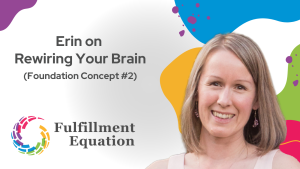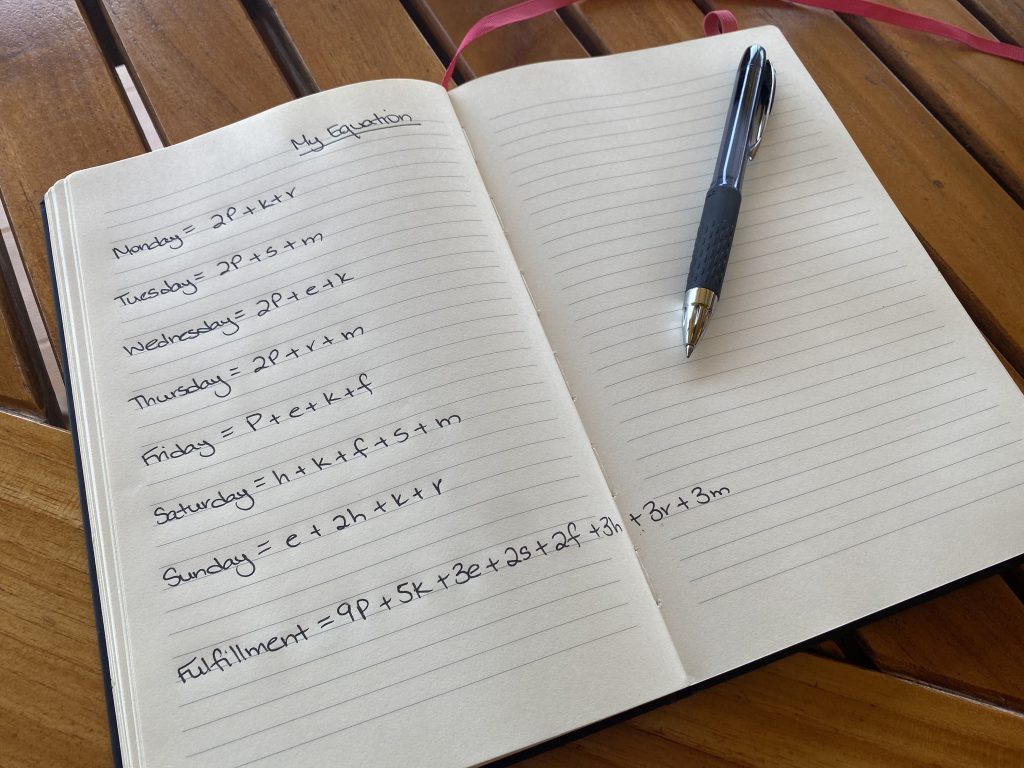
Why An Equation?
So, “why an equation?”, you might ask. Let’s first define what we mean. In mathematics, an equation is a formula that expresses the equality of two expressions by connecting them with the equals sign. It is also the process of equating one thing with another. Think of the equals sign as a giant tube that connects two containers of water: if you pour more water into one side, it’s going to bring the water level on the other side up to match it, and vice versa. Both sides of the equation rise and fall together. In other words, it is the scientific representation of balance.
When it comes to pursuing fulfillment, using the concept of an equation really accomplishes three key things. These three things are important to understand before we put pen to paper on drafting our own unique equation.

The first benefit is that it encourages us to adopt the mind of a scientist. By that I mean, we need to take on a growth mindset – we need to be curious, experimental, observant and willing to come at a problem from different angles. Embarking on the exercise of building an equation from the place of a fixed mindset is a recipe for disappointment. The truth is that if you are seeking the one perfect, long-lasting, never-changing, silver-bullet solution to fulfillment you will not find it here. This is because, as the Greek philosopher, Heraclitus, said so well, “the only constant in life is change”. When it comes to the fulfillment equation, we can do our best to build and refine the equation to a place of equilibrium and maximum satisfaction. Over time, though, things change. Our environment changes, the people around us change and we, ourselves, change and grow. So the equation needs to be flexible enough to continue to evolve and adapt. This is what makes it a journey and not a destination. We also need to be comfortable in our adopted “scientific” mindset to experiment and take calculated risks to try new things in our equation, and then observe and incorporate the results accordingly. This means interpreting an experiment that didn’t work as we’d expected, not as a failure, but rather as new information that will help us along our journey of refinement. More so, we need to remind ourselves to behave like a detached observer – not just viewing things through a lens of confirming what we already think, but actively being open to observations that might refute some of our preconceived assumptions. In short, the brain of a scientist!

The second benefit to using the concept of an equation is that it is concrete. There are lots of situations in life where going with your gut and feeling your way through things works really well. Intuition can be very powerful! However, as emotional beings, we can sometimes be overly swayed by feelings and subjectivity, especially when we’re right in the middle of things. Building an equation can help us stay objective and add some perspective to the emotional voices. To be fair, we don’t want to swing too far the other way and become completely robotic about it. Feeling the feelings, experiencing emotion and trusting our intuition is all part of our journey to finding fulfillment and of the human experience in general. The benefit is in tempering the extremes of our emotions and reducing the chances of falling into traps where we are hijacked by our own powerful feelings. In those cases, the concrete nature acts like a bit of an emotional reset, calming us down and bringing us back to a place of equilibrium.
Lastly, equations are all about relationships. The equals sign in the middle represents the relationship between what’s on one side of the equation and what’s on the other side. In our case, it identifies the relationship between fulfillment and the elements (or “clusters”). Fulfillment is on one side and we’re looking to build an equation using the elements in a way that will result in our sense of fulfillment going up – like pouring water into the conjoined containers. What’s really interesting about equations though, is that they also give us information about the relationships between elements in the formulas on either side of the equal sign. For example, if one dollar is equal to 5 dimes plus 10 nickels, and we know a dime is worth 10 cents, then we can automatically figure out that you need 2 nickels for every one dime. The relationship between dimes and nickels is 1:2. In our fulfillment equation, this becomes useful because we are really trying to figure out what the relationship is between elements on one side of the equation. By this we mean, how much of one thing would I need relative to another thing. It’s like narrowing in on the ratios needed for the various ingredients in your favourite recipe. The recipe is at its best when you have everything in the right proportions. In this same way, understanding the optimal proportions between elements allows us to maximize for fulfillment!
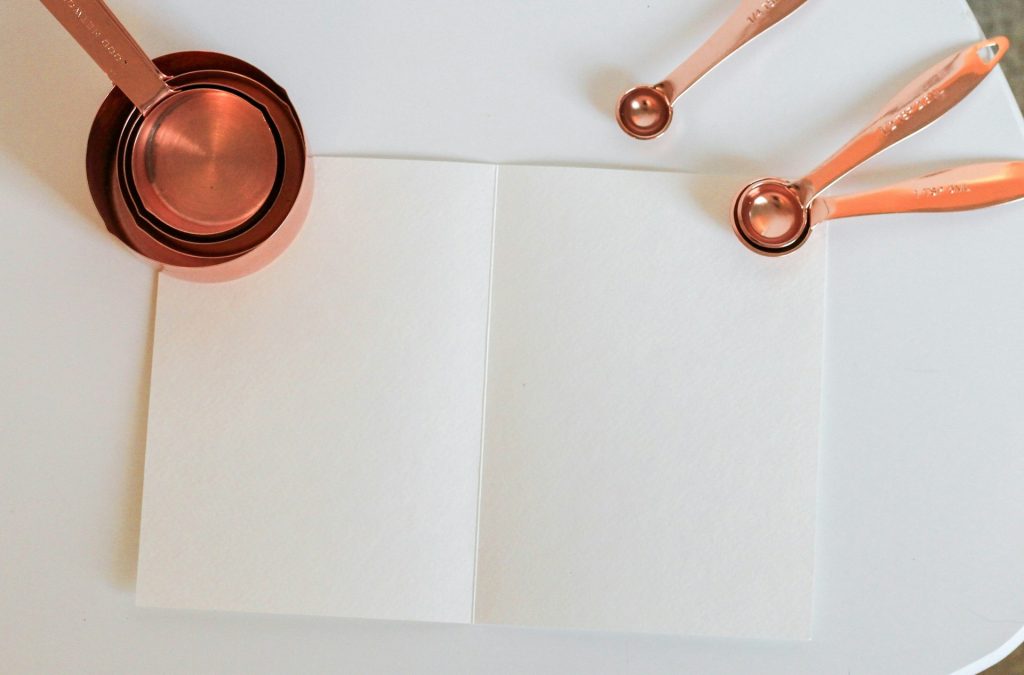
Building the Initial Equation
So let’s get down to the business of building your equation! Remember that this is the first draft and in the steps that follow we will continue to learn and make refinements to the equation. We won’t get it perfect the first time – even if it ever becomes “perfect”, things change and it would need to eventually change too. Like you, your equation is always evolving!
Start by getting a blank sheet of paper and write the days of the week down the side from top to bottom: Monday, Tuesday, Wednesday, Thursday, Friday, Saturday, Sunday. At the bottom, write the names of your clusters horizontally in one row.
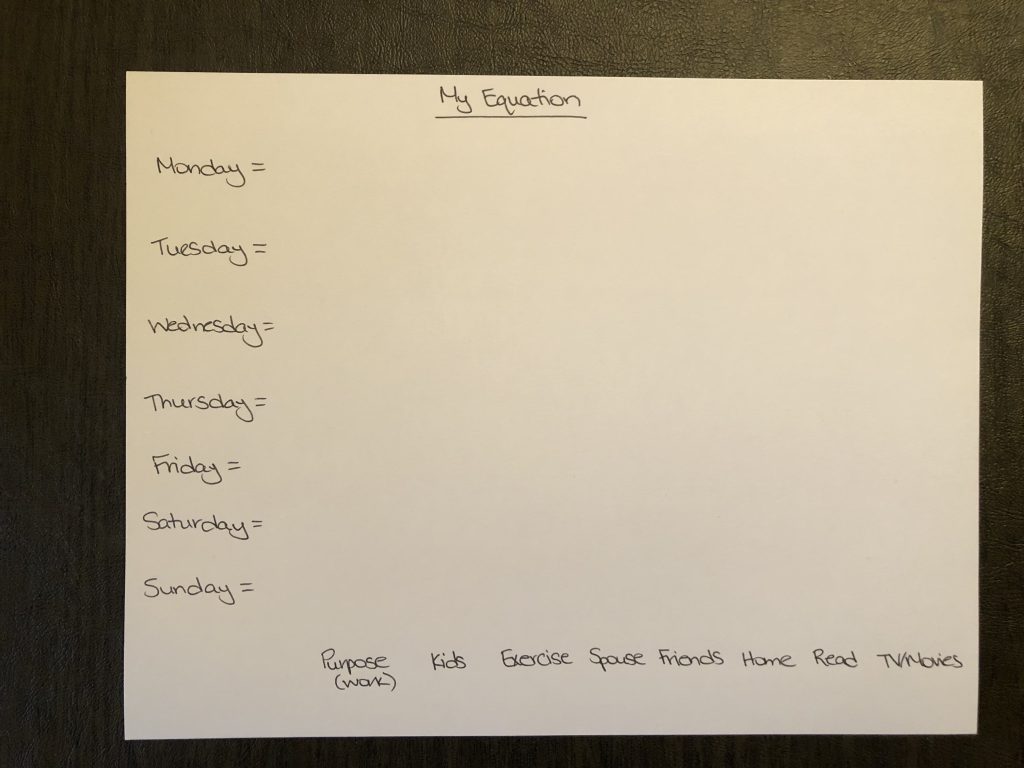
Now refer back to the word cloud. Let’s say you have between 6-9 clusters. Pretend you have a pile of building blocks for each cluster. Each pile is a different colour. The blocks are all the same size within a cluster. For the most part, they are also all the same size between clusters.
Each block represents about an hour of time, however this is one of the many places where there is a tension between the art and science of it all. We’re going to use the idea of a block being about an hour as a guide to help us protect the time. The intention is to provide the space to feel like you are able to get into quality engagement in that particular activity. Yet, we also don’t want to get too hung up on watching the clock. I expect we all have examples of times when we’ve done a thing for an hour and felt unsatisfied. Conversely, we also likely have examples of times when we’ve done a thing for far less time and felt completely fulfilled! When it comes to putting the equation into practice, we will need to pay attention to how we feel about the time we’re spending. However, for the purpose of building the equation, let’s assume a block is equivalent to about an hour.
There are a few rare cases where there may be an exception for a bigger block. I found this in my own equation when it came to a cluster I had labelled “Purpose”. Purpose was the group of items I had that were related to work and occupational priorities. Early on this was primarily the time I spent in my job. Over time, it transitioned to include more self-driven “work” activities, such as writing or creating. When it came to the Purpose cluster, it made sense to me to have a block represent more like 3 or 4 hours of time, particularly when I created my first equation because my job and routine back then was more conventional. This meant I could associate a block with the morning and a block with the afternoon, instead of using eight separate blocks for a typical work day.

Now, before we get ahead of ourselves in allocating blocks to particular days of the week, let’s first estimate how many blocks of each cluster you would ideally like in a week. Don’t worry at this point whether or not you have time in the week to accommodate them. Simply go through your list of clusters and mentally pull out blocks from the cluster piles as if they were flowers and you were making a beautiful bouquet. Feel through the exercise with your gut. Perhaps you want 4 of this and 2 of that, 3 of this and 1 of that. Write these numbers below each cluster name at the bottom of your page. This part will be iterative as adjustments will likely need to be made as you’re building your equation.
Here is where you get another point of tension: you can lean on your experience of knowing that certain things will need a particular amount of time (for example, you may have a cluster around “Home” and know that it will take 3 blocks a week to do cleaning, laundry, grocery shopping and other household chores), but don’t let that lead you to feel completely locked into those blocks for all of eternity. Build the first iteration of your equation drawing on some experience from your life as it is now, but don’t assume that you can’t change any of it if you hate doing those things. In this case, you will allocate 3 blocks for Home, but keep in mind that you want to actively work toward making it 1 block over time. Feel free to note this on your page in order to set the intention in your mind: “Home 3 (→ 1)”.
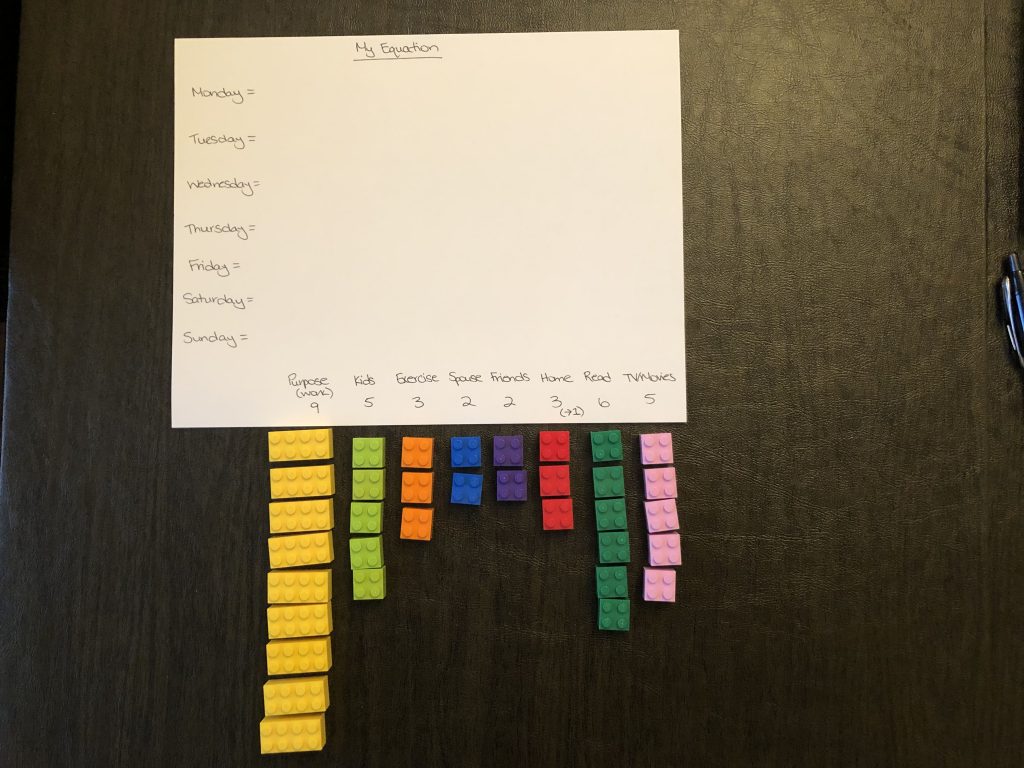
At this point, we’re going to now allocate the blocks to different days of the week. Begin by putting some of the less flexible blocks in first. In my case, I started with the larger “Purpose” blocks by writing “P” on the row next to “Monday” to represent the 3-4 hours of work I do in the morning and then did it a second time on the same row to represent the afternoon work. Between the two “P”s I placed a plus sign. It looked like this: Monday = P + P.
I repeated this for the rest of the work week, with the exception of Fridays when I worked half day. Fridays just had one block of “P”. For the time being, the work schedule I had was what it was. However, I’ve been deliberate in calling these pieces “less flexible” and not “immovable” because nothing is rigid. We’ll explore this more later on.

Before adding any more blocks into your equation, take a moment now to figure out how many block “spaces” you have to play with. In my case, I figured that apart from the larger “Purpose” blocks on weekdays, I really only had space for two other blocks each day and I also knew that those two other blocks couldn’t be that intense. It’s important to know your own personal energy cycles when considering where your empty block spaces might be and what you’re going to put in them. For me, after a full day of work, making dinner and putting the kids to bed, I usually have space for something that takes a bit of energy and then space for something that takes almost no energy. Planning for something that requires a lot of energy or focus at the end of a weekday would just lead to failure, frustration, exhaustion and dread. In essence, this would be a recipe for turning something I want to do into something that feels like I have to bring myself to do it. This is what I was trying to avoid.
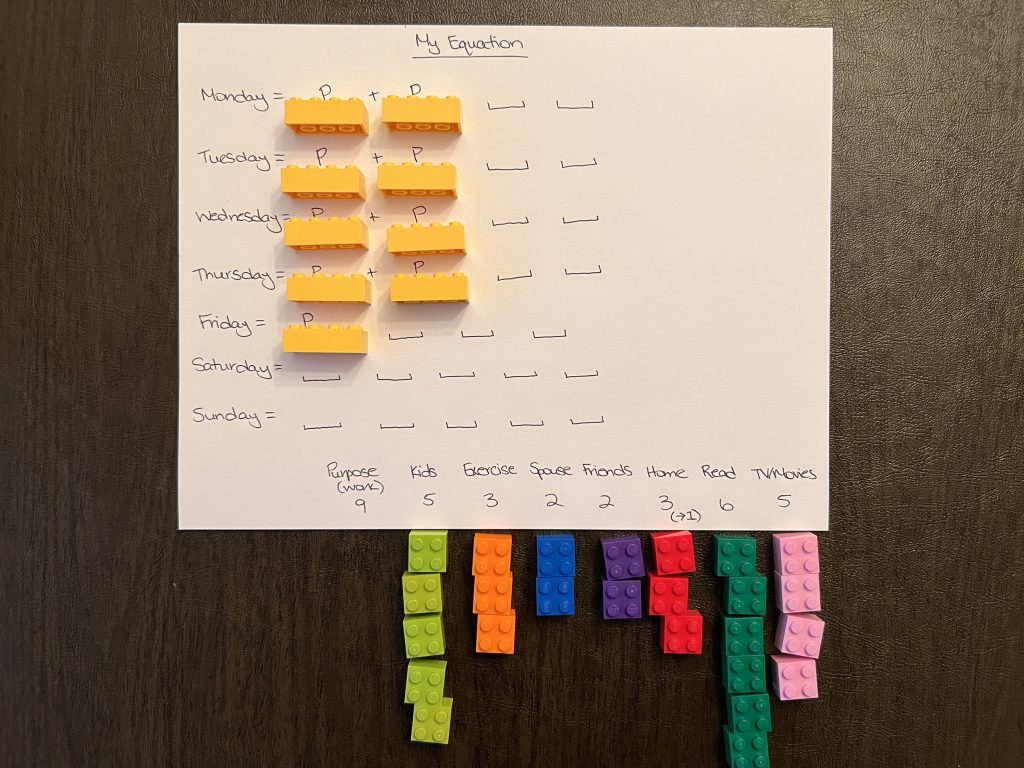
At this point, you have a few less flexible blocks placed next to your days of the week and then a sense for what open spaces you might have for blocks, as well as a general idea of the energy level you have for each of those open spaces. Now it’s time to add some more blocks to fill the empty spaces.
Next look for the clusters where you want something to happen routinely. This way, you can spread out the blocks for this cluster over the week. In my case, I have a cluster called “Health” which includes exercising. When I first built my equation, I had wanted to exercise 3 times a week. It wouldn’t make sense to put this all on the same day! So I spread it out by putting a block on Friday (my half-day of work) and a block on Sunday. But where to put the third block? I could put it on Saturday, but exercising three days in a row and then not at all for four days every week seemed silly. If I was to space it out evenly, it would need to land on a Tuesday or Wednesday. I put it on Wednesday knowing that I had a couple of options. Since I know that my own energy levels are lower in the evening, I found a yoga class at lunchtime and negotiated a longer lunch break on Wednesdays so that I could exercise mid-day. At other times, I would choose a walk after putting the kids to bed because this seemed to take less energy than a vigorous exercise class, but was still great for my body. The point is, be thoughtful about where you are scheduling your blocks, but also be creative about how you can make it happen if you want them to fall in a certain place.
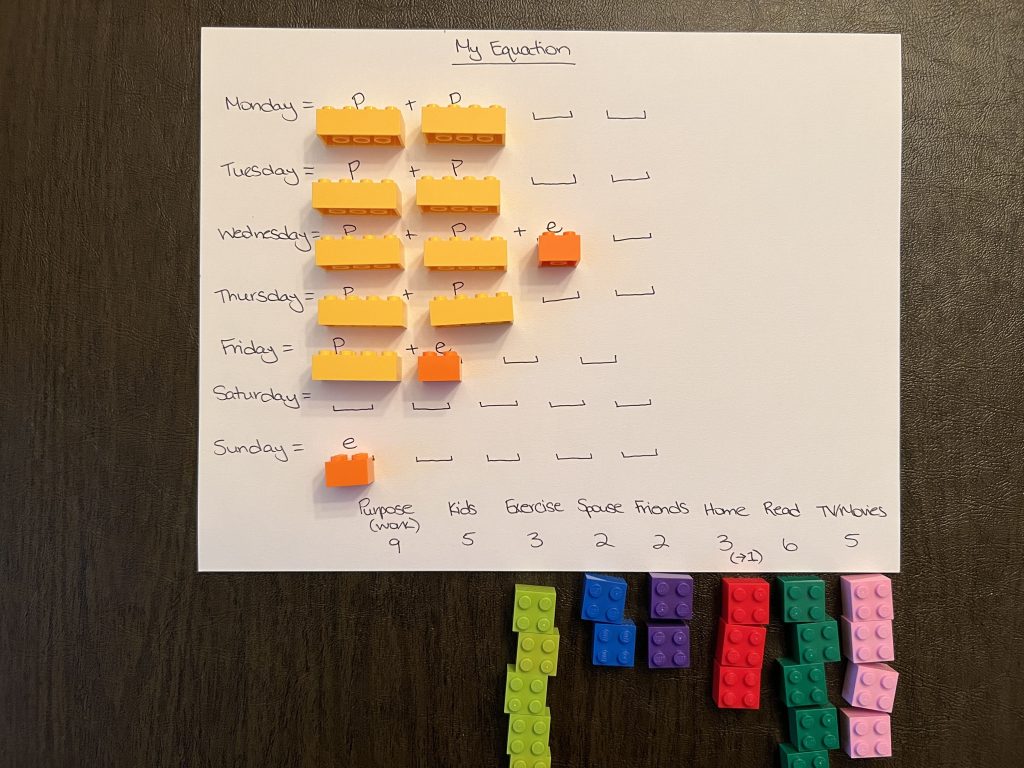
Now that you have your “less flexible” and “routine” blocks placed, start to add in the rest of the blocks you had identified for your various clusters. Some of these may need to go in certain places and others may be able to go anywhere. For example, I have a cluster called “Friends” and I knew that my activities with friends (whether it was a dinner out or book club or hanging out with other moms I know while our kids played after school pick-up) usually happened on Fridays. So I put the “Friends” block on Friday. As you’ll see in the next step, it doesn’t mean that it always has to happen on Fridays, just that it’s more likely to happen that way than if I’d put it randomly on a Monday. Place the blocks that are more likely to go in certain places first and save the ones that can go anywhere to place last as they will simply fill in the gaps. Continue to place your blocks until you have placed them all.
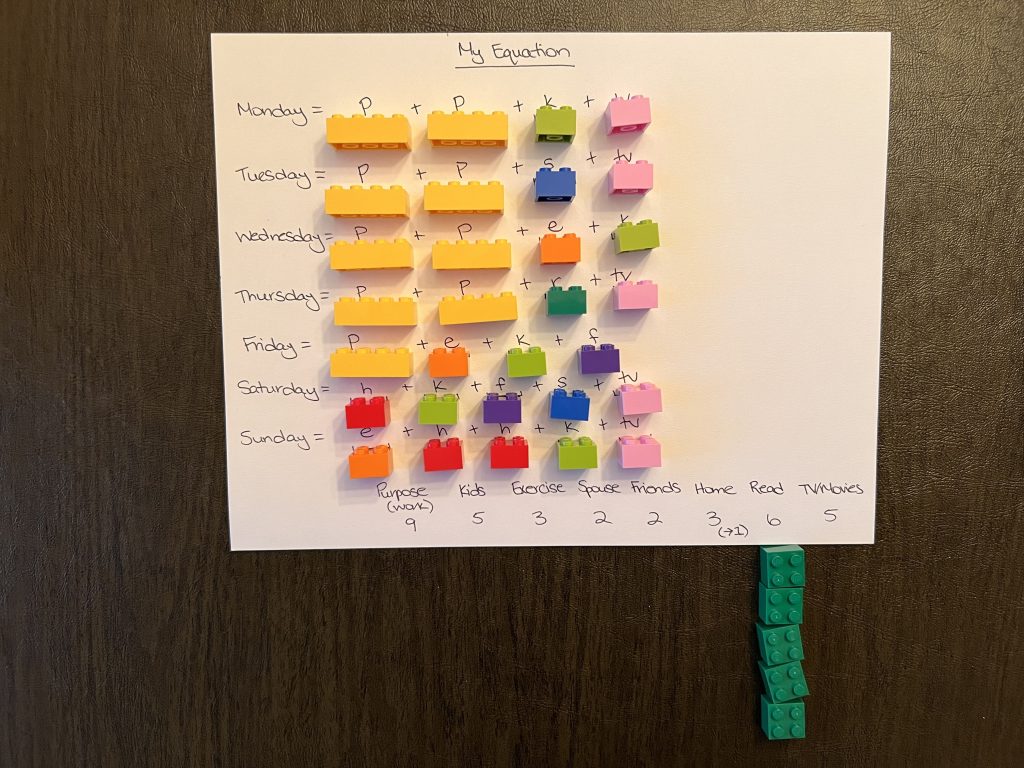
Refining the Initial Equation
This all works very well if your estimate of the number of blocks you would like to have in each cluster matches exactly how many empty spaces you have in the week. If that happened to you, congratulations! That’s pretty lucky. For most of us, we have to refine the initial equation to make it work.
What do I do if I have more spaces than blocks?
If you have more spaces than estimated blocks, then there are a couple of things you can do. The first option is to do nothing. Keep your equation light. After all, there’s no need to try to fill up every moment of every day! Spend a few weeks trying out the equation as it stands to see how it feels. The balance we are looking for is to feel on the one hand that you have good focus and are being deliberate about how you’re spending your time while on the other hand not feeling overly scheduled or structured. If you find you could use more focus, then you may want to consider adding more blocks in to fill some of the spaces. This is the second option and we will talk more about this in the next step.
What do I do if I have more blocks than spaces?
This is probably a more likely situation for many of us. In this case, we may need to refine some of our expectations. Perhaps we can’t have 10 blocks of “Friends” or “Hobbies” a week. Try scaling back slightly in some clusters. Remember that we can build an equation for today, while at the same time dream about the equation of tomorrow. As mentioned earlier, make a note beside your cluster estimates to set an intention to make a change: “Hobbies 3 (→ 5)”. As you’re refining down, remember to look across all your clusters to maintain a balance between them that feels right. Maybe you can spread out the reductions a little so that the ratios between clusters stay in proportion, rather than taking the overage completely out of one area. Refine until it fits, but be clear with yourself about whether it’s a change you are comfortable with (perhaps you were overzealous) or a change you are making a concession on (perhaps you’d really like to keep it, but just don’t have the space). If it’s the latter, don’t be defeated by it. This is the work of designing and driving towards changes over time that will get you closer to your ideal equation.
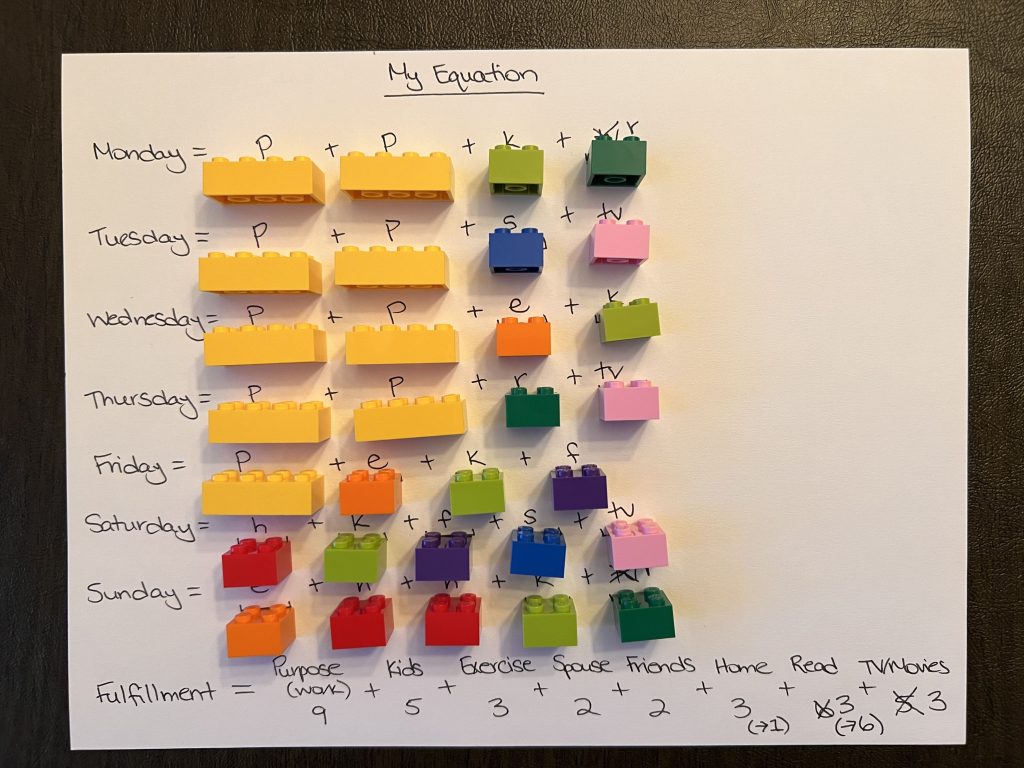
When your initial equation is done, review it to look for any final refinements. Examine the equation by day. Look across each day and visualize what that looks like. Is it realistic? Does it energize you? Is there balance? Perhaps you need to swap something you initially put on a Tuesday for something on a Saturday. Examine the equation as a whole. At the bottom of your sheet put a plus sign between each of your clusters and write “Fulfillment =” at the beginning of the row. This becomes the first draft of your own unique fulfillment equation. Again, ask yourself: Is it realistic? Does it energize you? Is there balance? If not, refine it further. If so, then it’s now time to put the equation into practice as we track, analyze and adjust the equation over time.
Read Next Article: Step 3 – Putting Your Equation Into Practice



